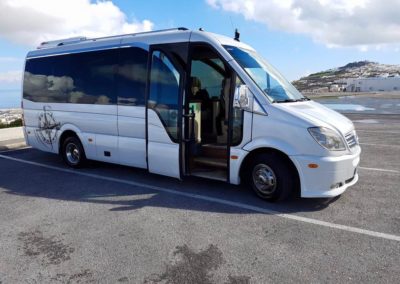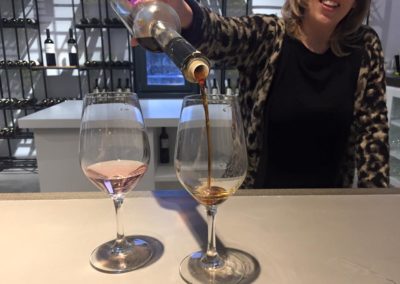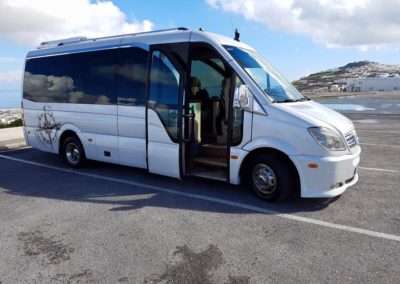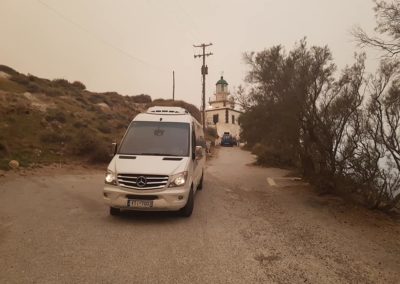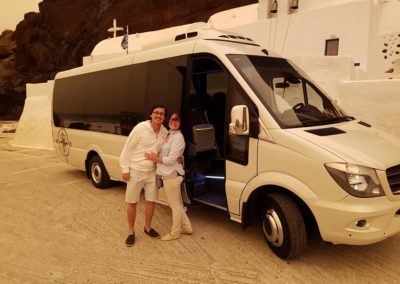Half Day Private Tours
1st Half Day
Program
2st Half Day
Program
3rd Half Day
Program
1st Half Day
Program
First stop to Profitis Ilias mountain.
The highest spot of the island (567 meters) is located between Pyrgos and
Kamari. The Mountain’s name is ProfitisIlias (Prophet Elijah), coming from the
Monastery with the same name on its peak. From this vantage point, you will
enjoy a striking view of the entire island, from the patchwork agricultural plains to the hilltop village of Oia.
The Monastery was built in 1712. The walls round the Monastery remind of a
fortress. The history of ProfitisIlias is long and very importand for the life of
Santorini during the centuries. In earlier times, owned its’ own ship which
conducted private business for the benefit of the monastery and at the same time the Monastery was an active intellectual and patriotic influence. From 1806 to 1845 it ran a school where the Greek language and literature were taugh.
The monastery’s decline began in 1860; buildings suffered serious damage in the 1956 earthquakes. The monastery today has an important collection of icons and bibles, and artefacts of the Greek Orthodox religion, ecclesiastical objects, books and ethnographic material. It also hosts displays on shoemaking, printing, candle making, wine making and of typical local food.
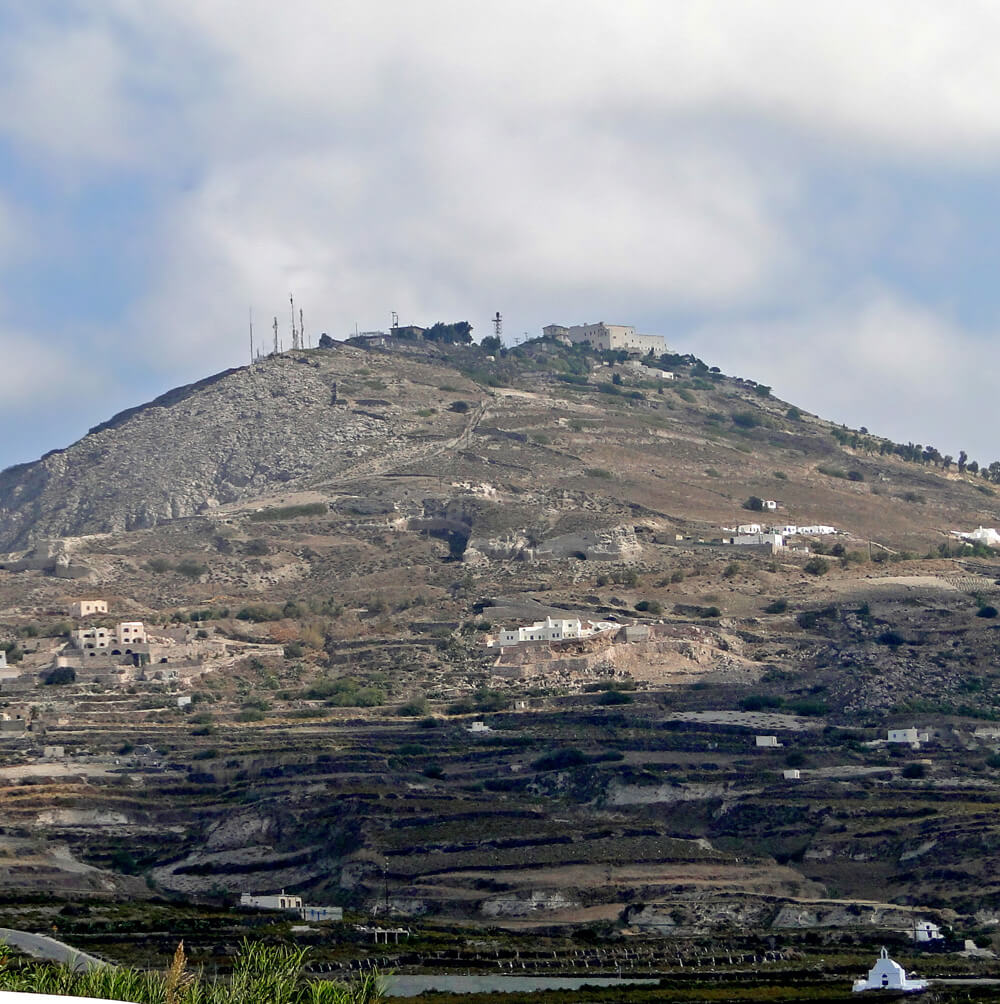
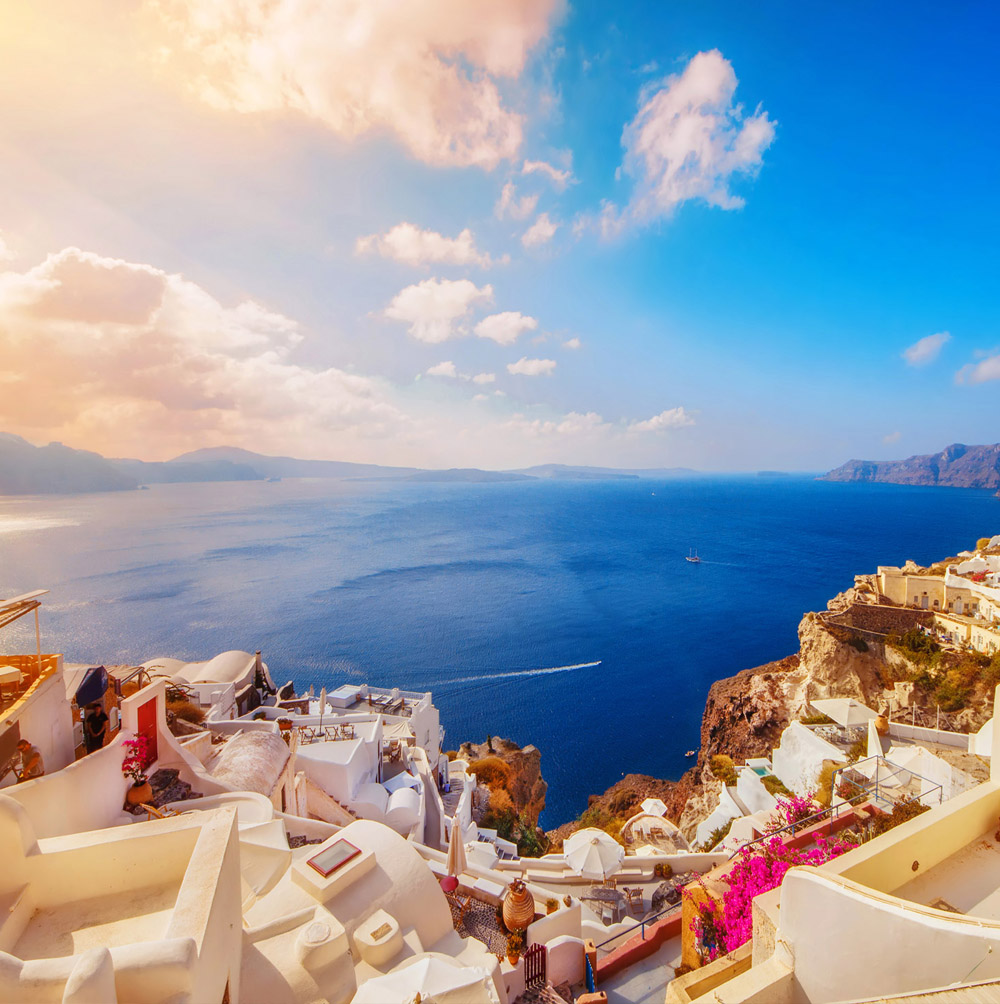
Next stop in Oia village.
The natural beauty of Oia village in combination with its traditional architecture which consists of white washed houses, old mansions where captains used to live, narrow streets and blue domed churches, make this village unique thus extremely popular to the visitors.
Photos and postal cards with the sunset of Oia, the caldera view and the churches with the blue domes have travelled all over the world advertising the incomparable beauty of the village and making even more people wishing to visit it!
Next stop, Immerovigli
Next stop, Immerovigli that it is a picturesque village. It is situated at the north
of Santorini, only 2 km away from the capital of Fira. It is a continuation of Fira
and one of the most beautiful balconies of the island. The name of Imerovigli
comes from the word vigla which means view spot.
The position of the village provides a clear view of the caldera, and during the old times it allowed villagers to see the pirate ships approaching. Today, Immerovigli is one of the recognized traditional settlements.
Hotels and traditional houses are plentiful in Imerovigli. There are also many taverns and cafes with stunning views to the caldera. In front of Immerovigli lies an enormous rock called Scaros.On top of it is a castle that was built during the 13th century but it was bandoned in the early 1800s.
The castle housed all the administrative offices of the island. This part of the island collapsed after an earthquake, and only the huge hill of Scaros is left today.
Immerovigli has numerous chapels and churches built on the rocks overlooking the blue sea. The village is known as the ultimate romantic destination.
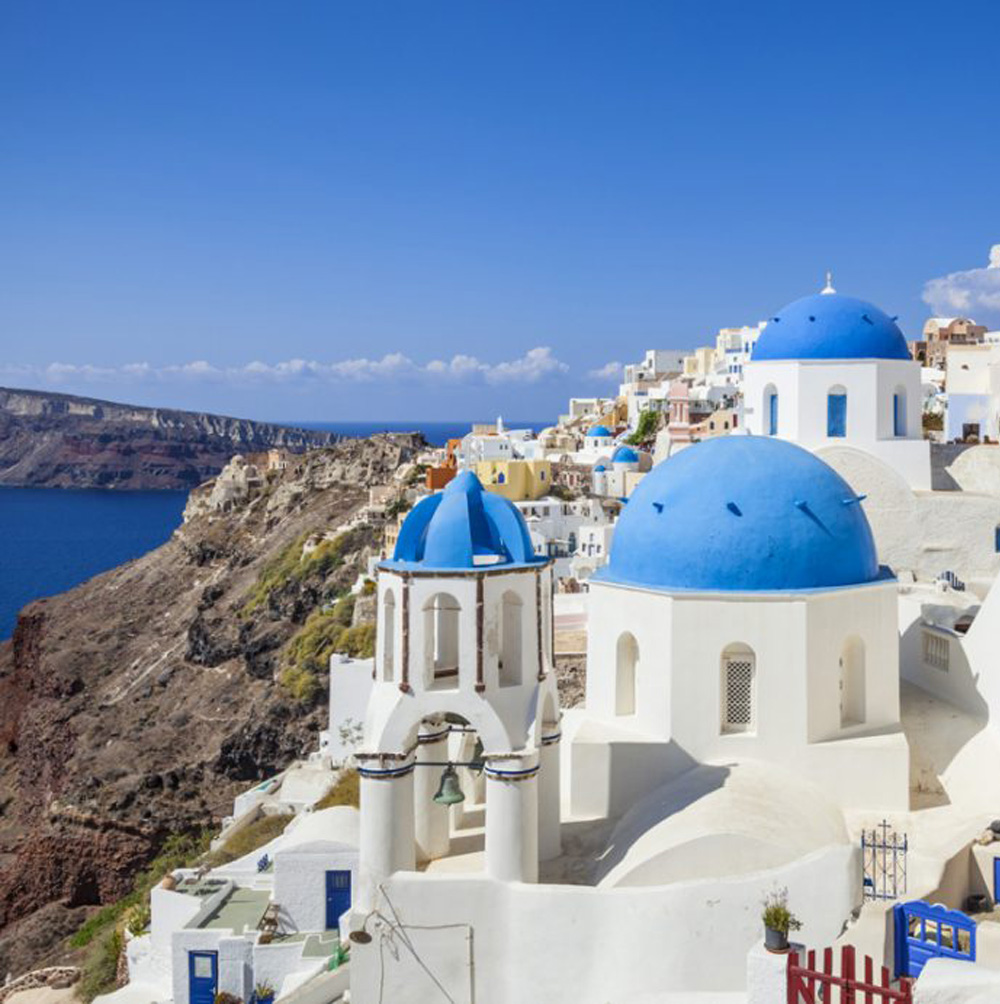
Firostefani is to the north of Fira and there is little difference that separates it from its considerable larger neighbor. Without a doubt, the views from this part of Santorini are spectacular, offering another perspective of Santorini volcano. One can enjoy the magnificent sight of Fira itself and the breathtaking sunset in the evening. The village has plenty of restaurants and cafes located on the most fabulous locations. Between the village of Firostefani and Imerovigli lies the AgiosNikolas Monastery. Hotels are plenty in Firostefania.
Note: You will enjoy a walking tour from Firostefani to Fira.
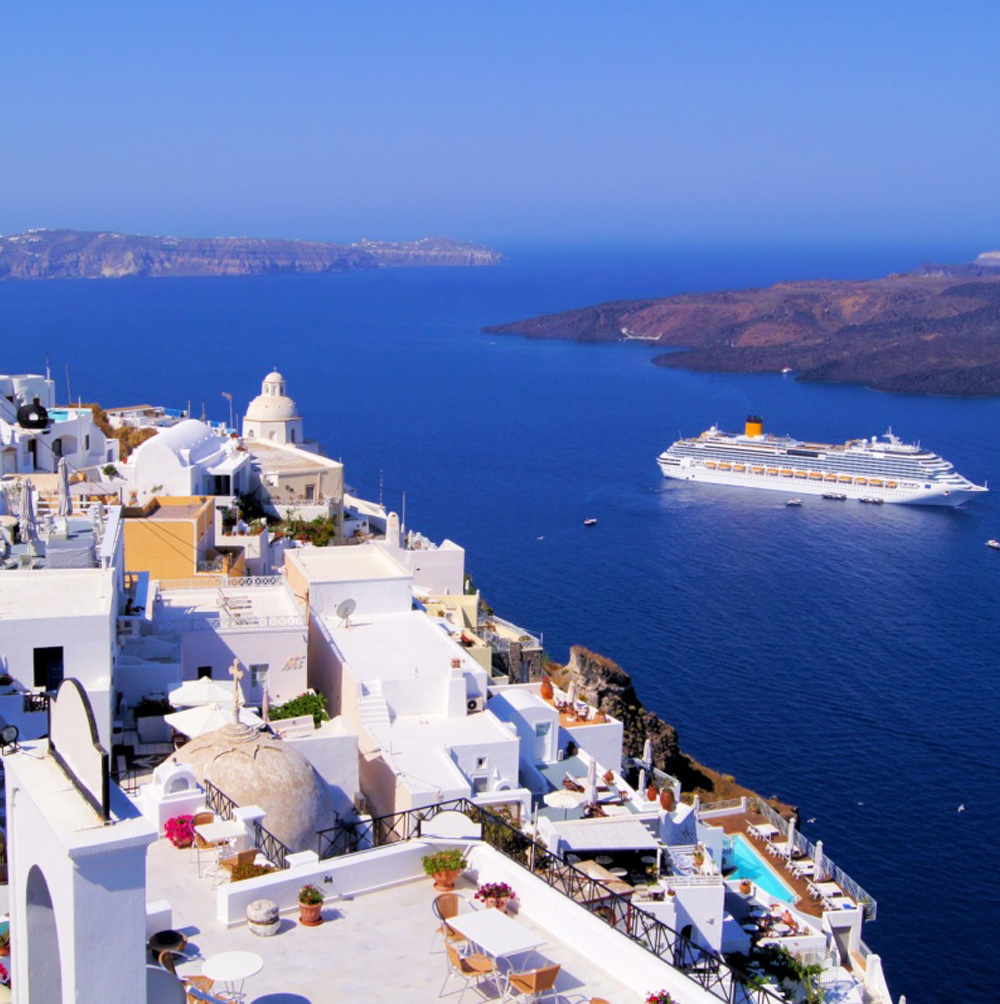
Final stop in Fira.
Fira is the capital of Santorini. On the caldera side you get one of the best views of the island and the activity level is enough to keep you entertained for hours. There are cafes, bars, restaurants, the most of them with view of caldera and some with several levels of patios and balconies to make the most of the space they have and the fact that when there are several cruise ships sitting below the town is packed with tourists.
If you enjoy shopping or eating or drinking or hanging out and watching the view then, Fira is worth visiting for a few hours in the day or evening.
The port of Fira below is where the cruise ships anchor and the tenders come and get the passangers and take them to the small port where they have three choices. The first choice, and maybe the most sensible one is to take the cable-car.
The second choice is to go up by donkey, which is what a lot of people end up having to do because they promised their kids that they would do this to get them excited about coming to Santorini.
The third choice is to walk which is done only by people who are in terrific shape and like a challenge or have something to prove.
Many people stop for a visit at the Santorini Archaeological Museum which has artifacts mostly from ancient Thira as well as stuff from around the island from the various historical periods from the 5th Century to Roman times. It is open daily from 8:30 to 15:00 and closed on Mondays. There are several other smaller museums in town including the MegaroGyzi Museum, near the cable-car entrance, which has old Santorini photos, paintings and manuscripts in a 17th Century mansion. Open daily except Sunday from 10:00 to 16:00 between May and October.
Most of the restaurants in Fira are tourist restaurants. You can taste all kind of food like , souvlaki, greek food, chinece food etc.
In our price included the tour by mini bus Mercedes vito or sprinter and the driver escort. Excluded tickets of museums, cable car and lunch.
2st Half Day
Program
First stop to Profitis Ilias mountain.
The highest spot of the island (567 meters) is located between Pyrgos and
Kamari. The Mountain’s name is ProfitisIlias (Prophet Elijah), coming from the
Monastery with the same name on its peak. From this vantage point, you will
enjoy a striking view of the entire island, from the patchwork agricultural plains to the hilltop village of Oia.
The Monastery was built in 1712. The walls round the Monastery remind of a
fortress. The history of ProfitisIlias is long and very importand for the life of
Santorini during the centuries. In earlier times, owned its’ own ship which
conducted private business for the benefit of the monastery and at the same time the Monastery was an active intellectual and patriotic influence. From 1806 to 1845 it ran a school where the Greek language and literature were taugh.
The monastery’s decline began in 1860; buildings suffered serious damage in the 1956 earthquakes. The monastery today has an important collection of icons and bibles, and artefacts of the Greek Orthodox religion, ecclesiastical objects, books and ethnographic material. It also hosts displays on shoemaking, printing, candle making, wine making and of typical local food.

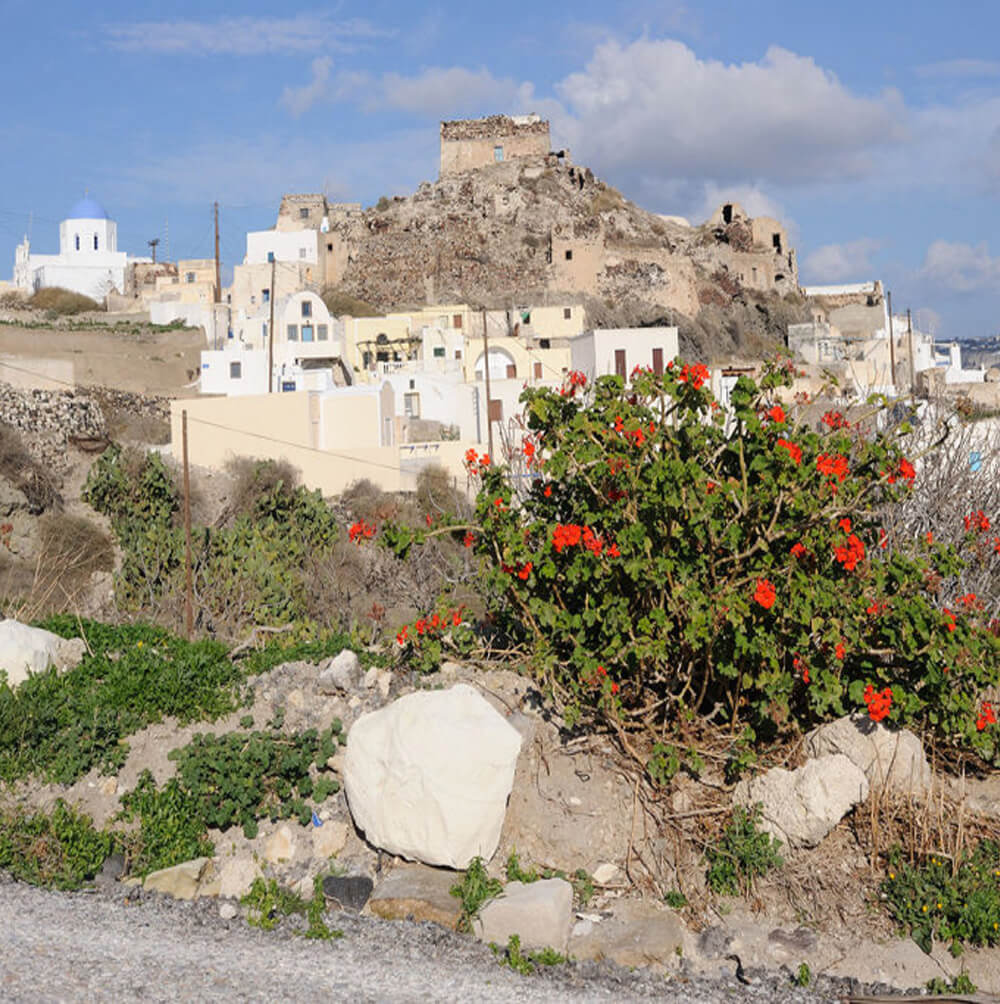
Next stop in Akrotiri.
Akrotiri is located next to the famous Red Beach. It is ampitheatrically built at the southeastern side of the island. Akrotiri was originally a Minoan settlement and today is one of the major tourist attractions and the most important archeological site of Santorini.
The prehistoric town was destroyed due to a massive volcanic erruption around 1600 BC. Nowadays, the picturesque streets, the two-storey buildings, the lovely frescoes and plenty of tools witness the way of life in the prehistoric times.
Today, the beautiful frescoes of the ancient city of Akrotiri can only be seen in the National Archaeological Museum of Athens.
Some splendid houses are dotted around the village as well as a traditional windmill. Many tour boats arrive in Akrotiri and tourists are scattered to the nearby beaches of the area. Another place of interest is the Venetian castle that dominates the settlement of Akrotiri.
The town has lovely hotels and also many local taverns with a splendid view to the sea. Akrotiri has plenty of churches to visit and one of the most beautiful is the church of Agios Nikolaos built right above the impressive redish rocks, on the way to the Red Beach.
Next stop, Red Beach
Next stop, Red beach that it is arguably one of the most famous and beautiful beaches of Santorini. It is located only some steps away from the ancient site of Akrotiri.
The small size of the beach creates a much crowded atmosphere and there are many days where most of the visitors choose not to make it all the way down to the beach and instead admire this unique landscape of red and black volcanic rocks from the headland.
After it, we will meet in Akrotiri a local family that they produce local wines and products .we will taste three local wines like Asyrtiko, Nikteri and Vinsanto.
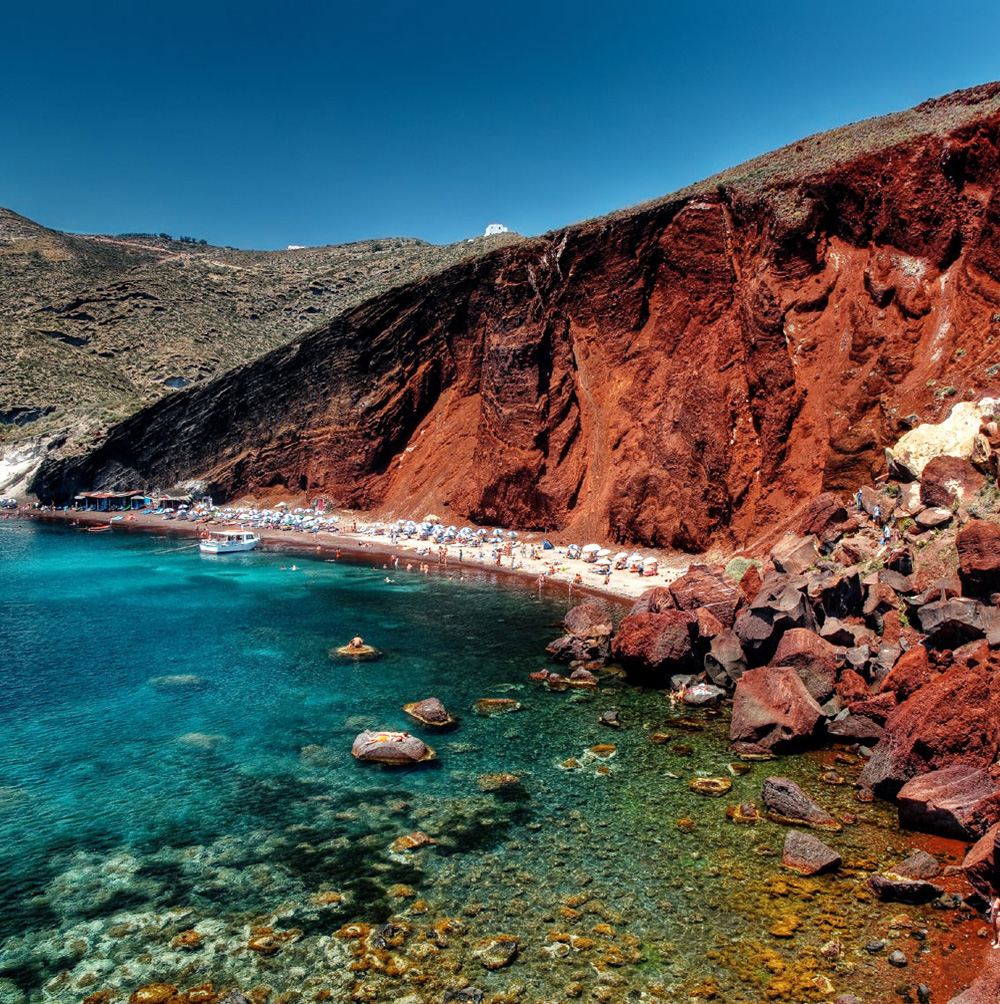

Next stop Lighthouse in Akrotiri.
Santorini Akrotiri Lighthouse: The Akrotiri Lighthouse is among the oldest lighthouses in Greece and was constructed way back in 1892.
It stands like a sentinel towards the on the southern peninsula of Santorini island. The lighthouse of Akrotiri is conspicuous by its square-shaped tower that looms above 10 meters from the lighthouse warden’s house.
Initially, the lighthouse was operated by petrol fuel. But with the introduction of electricity in the year 1988, it has been operated electronically and reportedly emits a radiant white light at intervals of 20 seconds.
According to historical records, the Akrotiri Lighthouse was built by a renowned French trading company in the year 1892.
The peripheral area surrounding the lighthouse is replete with vestiges of the Minoan period which is regarded by many scholars as the high water mark of the Aegean culture and civilization.
The best time to visit the Akrotiri Lighthouse is during sunset. The view of the red molten ball dipping into the azure blue Aegean Sea makes for a kaleidoscopic vignette.
Next stop, Black Beach
Black beach is a beautiful beach situated 15 km southeast of Fira extending for 7 km on the southeastern side of Santorini.
The beach features unique charateristics, black sand, crystalline waters and various beach facilities.
However, the enormous rock called Mesa Vouno that rises from the sea is the main attraction of the beach and the entire area. Visitors are left spellbound by the stunning view of the rock especially when it shines in the dark.
Perissa is a nice tourist resort witnessing a huge tourist movement that starts from in the middle of the summer season.
The village offers a great variety of hotels for all tastes and budgets, restaurants, taverns, cafes and bars.
The area is extremely developed with modern amenities and quite inviting while retaining its strong traditional character.
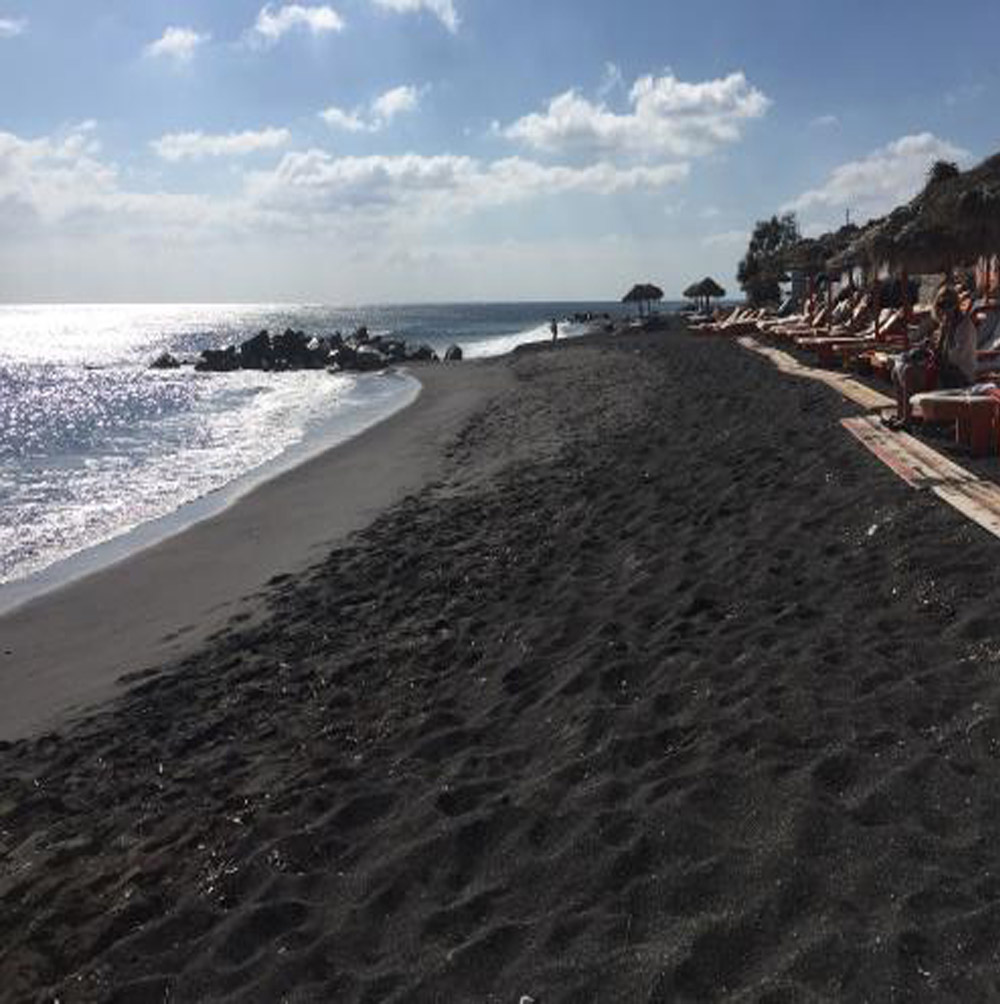
Many people stop for a visit at the Santorini Archaeological Museum which has artifacts mostly from ancient Thira as well as stuff from around the island from the various historical periods from the 5th Century to Roman times. It is open daily from 8:30 to 15:00 and closed on Mondays. There are several other smaller museums in town including the MegaroGyzi Museum, near the cable-car entrance, which has old Santorini photos, paintings and manuscripts in a 17th Century mansion. Open daily except Sunday from 10:00 to 16:00 between May and October.
Most of the restaurants in Fira are tourist restaurants. You can taste all kind of food like , souvlaki, greek food, chinece food etc.
In our price included the tour by mini bus Mercedes vito or sprinter and the driver escort. Excluded tickets of museums, cable car and lunch.
3rd Half Day
Program

First stop in Oia village.
The natural beauty of Oia village in combination with its traditional architecture which consists of white washed houses, old mansions where captains used to live, narrow streets and blue domed churches, make this village unique thus extremely popular to the visitors.
Photos and postal cards with the sunset of Oia, the caldera view and the churches with the blue domes have travelled all over the world advertising the incomparable beauty of the village and making even more people wishing to visit it!
Next stop in Akrotiri.
Akrotiri is located next to the famous Red Beach. It is ampitheatrically built at the southeastern side of the island. Akrotiri was originally a Minoan settlement and today is one of the major tourist attractions and the most important archeological site of Santorini.
The prehistoric town was destroyed due to a massive volcanic erruption around 1600 BC. Nowadays, the picturesque streets, the two-storey buildings, the lovely frescoes and plenty of tools witness the way of life in the prehistoric times.
Today, the beautiful frescoes of the ancient city of Akrotiri can only be seen in the National Archaeological Museum of Athens.
Some splendid houses are dotted around the village as well as a traditional windmill. Many tour boats arrive in Akrotiri and tourists are scattered to the nearby beaches of the area. Another place of interest is the Venetian castle that dominates the settlement of Akrotiri.
The town has lovely hotels and also many local taverns with a splendid view to the sea. Akrotiri has plenty of churches to visit and one of the most beautiful is the church of Agios Nikolaos built right above the impressive redish rocks, on the way to the Red Beach.


Next stop, Red Beach
Next stop, Red beach that it is arguably one of the most famous and beautiful beaches of Santorini. It is located only some steps away from the ancient site of Akrotiri.
The small size of the beach creates a much crowded atmosphere and there are many days where most of the visitors choose not to make it all the way down to the beach and instead admire this unique landscape of red and black volcanic rocks from the headland.
After it, we will meet in Akrotiri a local family that they produce local wines and products . We will taste three local wines like Asyrtiko, Nikteri and Vinsanto.
Firostefani walking tour up to Fira
Firostefani is to the north of Fira and there is little difference that separates it
from its considerable larger neighbor.
Without a doubt, the views from this part of Santorini are spectacular, offering another perspective of Santorini volcano.
One can enjoy the magnificent sight of Fira itself and the breathtaking sunset in the evening. The village has plenty of restaurants and cafes located on the most fabulous locations.
Between the village of Firostefani and Imerovigli lies the AgiosNikolas Monastery. Hotels are plenty in Firostefania.
They are quite picturesque with vividly colored houses. There are also few shops, most of them are concentrated at the main shopping street, at the centre of Firostefani.

Many people stop for a visit at the Santorini Archaeological Museum which has artifacts mostly from ancient Thira as well as stuff from around the island from the various historical periods from the 5th Century to Roman times. It is open daily from 8:30 to 15:00 and closed on Mondays. There are several other smaller museums in town including the MegaroGyzi Museum, near the cable-car entrance, which has old Santorini photos, paintings and manuscripts in a 17th Century mansion. Open daily except Sunday from 10:00 to 16:00 between May and October.
Most of the restaurants in Fira are tourist restaurants. You can taste all kind of food like , souvlaki, greek food, chinece food etc.
In our price included the tour by mini bus Mercedes vito or sprinter and the driver escort. Excluded tickets of museums, cable car and lunch.


